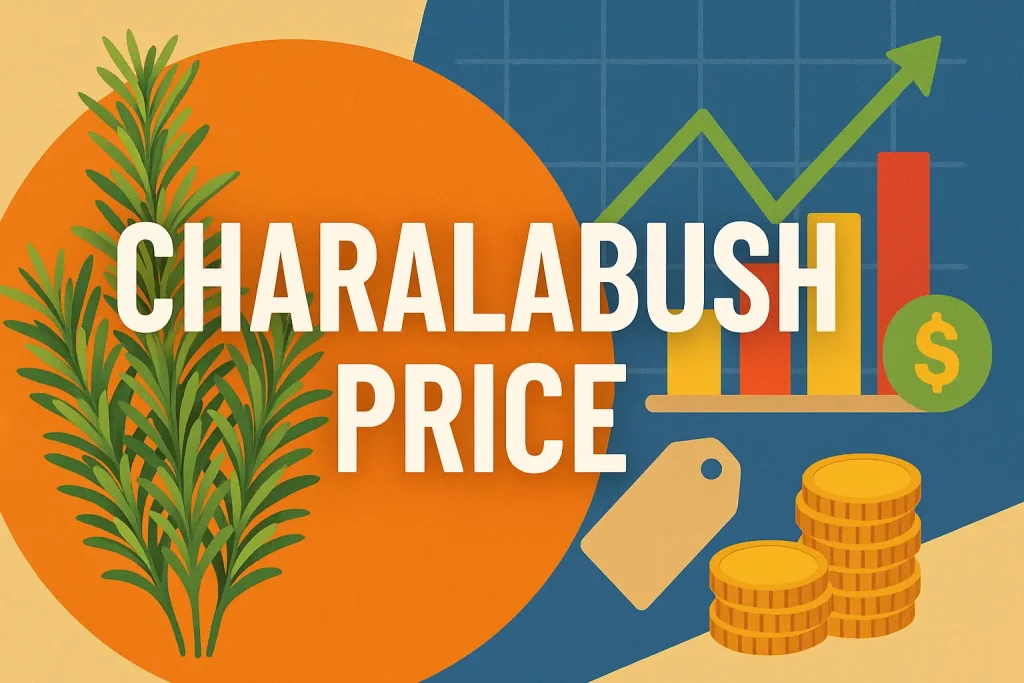
Charalabush is quickly becoming one of the most intriguing and talked-about plants in global agriculture. From the fields of local farmers to premium listings on international online marketplaces like Amazon and Alibaba, its demand is surging—and so is the curiosity about the charalabush price. Whether you’re a trader, consumer, or agricultural investor, understanding how charalabush is priced helps you make informed, smart decisions.
With increasing global awareness of sustainable farming, the market demand for charalabush is rapidly growing. It’s not just about the product anymore—it’s about where it comes from, how it’s grown, and how much it costs. This guide dives deep into every aspect of charalabush market rates and offers trustworthy, research-backed insights for anyone interested in this thriving commodity.
What is Charalabush Price?
The term “charalabush price” refers to the current cost of the plant, whether sold in potted form, as raw material, or in bulk commodity format. It may vary based on size, region, availability, and quality. Prices fluctuate depending on seasonal pricing trends, demand, and international trade dynamics. Understanding these numbers means understanding the underlying economics of the agricultural ecosystem.
From small nurseries to wholesale suppliers and online retailers, the price of charalabush can range from $10 for a small plant to over $150 for a mature one. Meanwhile, the charalabush per kg price varies across regions, which brings complexity—and opportunity—for buyers and sellers alike.
Also Read: https://gossipsmag.co.uk/geekzilla-ces-2023/
Charalabush Price Trends and Global Market Overview
The global market for charalabush is heating up. In countries like Pakistan, India, and parts of Africa, prices have steadily increased due to rising local use and international interest. According to regional agricultural boards, the last five years have seen a 25% rise in the charalabush market rate, signaling growing popularity and profitability.
Furthermore, the growing interest from international trade organizations has expanded the market reach. Export volumes are climbing, especially to Europe and the Middle East. This surge is also reflected in the presence of charalabush listings on platforms like Daraz and Alibaba, enhancing accessibility while also influencing price fluctuations.
Charalabush as a Plant and What It Costs Based on Size and Type
When purchased as a plant, pricing depends on size and maturity. A small charalabush plant typically costs between $10 and $30, while medium-sized versions range from $30 to $60. Fully grown plants or ornamental varieties often fetch up to $150 or more. These prices account for cultivation and harvesting cost as well as aesthetics.
The charalabush plant price also differs based on whether it’s sold by local nurseries or commercial farming suppliers. Locally grown options are usually more affordable, while imported or rare varieties carry a premium due to supply chain impact and transport costs.
Charalabush as a Commodity and Regional Price Differences
When sold as a commodity, charalabush is priced by weight. In the United States, for example, charalabush per kg price ranges from $10 to $15, while in Europe, it’s around €8–€12. Countries with established agricultural cooperatives, like India and Kenya, report rates between $5–$8 per kg, depending on local yield and demand.
Regional price variations are common due to factors like labor costs, weather patterns, and infrastructure. Some regions produce charalabush more efficiently, lowering costs, while others depend on imports, which can increase local prices.
Current Charalabush Price Per Kilogram in Different Countries
Here’s a snapshot of the average charalabush per kg price in key countries:
- United States: $12–$15/kg
- India: $6–$9/kg
- Pakistan: PKR 800–1200/kg
- Kenya: $5–$7/kg
- Germany: €10–€12/kg
These numbers are compiled from export-import agencies and trade boards, providing an authentic view of real-time pricing. It’s essential to account for shipping, packaging, and quality variations when comparing rates across borders.
Factors That Affect the Cost of Charalabush Worldwide
Several factors influence charalabush market rates worldwide. These include availability, farming practices, currency value, and the overall agricultural commodity rates. High-demand periods often trigger price spikes, while oversupply can reduce the cost temporarily.
Another major contributor is the level of investment in farming technology. Regions that support innovation and sustainability tend to yield better products at lower prices, helping both local farmers and international buyers benefit from improved local charalabush pricing.
The Impact of Seasonality and Regional Supply on Charalabush Pricing
Seasonality is one of the most impactful factors affecting charalabush prices. During peak harvest months, supply increases, and prices dip. Off-season periods bring scarcity, pushing prices up. This predictable pattern creates opportunities for strategic purchasing.
Regions with stable climates and consistent rainfall tend to offer better seasonal pricing trends. On the other hand, countries facing droughts or floods may see severe price jumps due to damaged crops and supply shortages.
Economic and Political Influences on Charalabush Market Rates
Political stability, import/export laws, and tariffs play a big role in pricing. When international trade organizations negotiate deals or impose restrictions, it directly affects the availability and pricing of charalabush.
Currency fluctuations also impact charalabush raw material rate, particularly when transactions occur across different economic zones. A weak local currency may increase export prices while benefiting foreign buyers.
How Quality, Form, and Processing Drive Charalabush Costs
Charalabush comes in many forms—fresh, dried, raw, or processed. Naturally, each has a different price point. The dried charalabush price is usually higher due to processing time and preservation quality.
Premium products grown under organic conditions or with sustainable practices fetch higher rates. Packaging, certification, and shelf life also influence how charalabush is priced across online marketplaces.
Tips for Buying Charalabush at Competitive and Fair Prices
To secure the best deals, always compare rates across platforms and regions. Look for seasonal promotions or buy directly from farming suppliers and local farmers to reduce middleman costs.
Joining agricultural cooperatives or subscribing to trade bulletins can help you stay ahead of market changes. Always verify quality and shipping details before placing large orders.
Where to Buy Charalabush Online and Offline for the Best Deals
You can buy charalabush online from platforms like Amazon, Alibaba, and Daraz. These portals offer global access and vendor reviews to ensure credibility. Offline, agricultural expos and local trade shows often feature competitive pricing.
For serious buyers, forming direct relationships with export-import agencies ensures not only better pricing but also priority supply during scarcity.
How to Get Discounts on Charalabush Through Bulk Purchases
Bulk buying is a powerful strategy. Most vendors provide generous discounts for large purchases, especially during high-supply seasons. Buying in quantity also reduces packaging and logistics costs, maximizing value.
If you’re sourcing for resale or industrial use, try negotiating long-term contracts with preferred suppliers. This shields you from price fluctuations and ensures consistency.
Cost Comparison of Charalabush Between Local and Global Vendors
Local vendors often offer fresher products at lower prices due to reduced logistics. However, global vendors may offer more variety and better packaging for international transport.
Comparing pricing structures helps reveal hidden costs. Make sure to factor in taxes, tariffs, and delivery charges when calculating total expenses.
How Charalabush Farming and Harvesting Influence Its Price
Farming techniques greatly influence charalabush farming cost. Traditional methods may be cheaper but less efficient. Modern, mechanized farming boosts yield and reduces per-unit costs.
Labor availability and soil quality also matter. Areas that struggle with workforce shortages or degraded farmland may experience higher production costs, affecting retail pricing.
Pricing Analysis Between Fresh, Raw, and Processed Charalabush
Fresh charalabush is typically sold at a lower price due to its short shelf life. Raw material rates are generally moderate, while processed varieties—due to drying, sorting, and packaging—are more expensive.
The extra cost in processed charalabush reflects added value, including convenience and longer usability. Buyers must assess their needs before deciding which format offers the best value.
Understanding Charalabush Pricing for Retailers and Distributors
Retailers need to factor in storage, shipping, marketing, and wastage costs when pricing charalabush for resale. Distributors, on the other hand, focus on volume and dependability.
Building good relationships with farming suppliers and agricultural cooperatives helps ensure a steady supply of charalabush at competitive rates, maintaining profitability and consumer satisfaction.
How to Monitor Market Trends for Smart Charalabush Buying Decisions
Subscribe to price tracking tools and agricultural journals to monitor updates on agricultural commodity rates. This insight allows for timely purchasing decisions.
Staying informed also empowers negotiation. When you understand supply and demand cycles, you can predict pricing changes and act accordingly.
Export and Import Value of Charalabush in International Trade
The import and export value of charalabush has steadily climbed in recent years. Global demand has opened up new trade routes and partnerships.
Countries that have established export systems benefit from foreign investment and better charalabush market rates, while importers enjoy diversified supply chains.
Packaging, Shipping, and Logistics Costs That Affect Charalabush Pricing
Logistics significantly influence the final cost. Bulk packaging reduces shipping expenses but may impact freshness. Smaller packages ensure quality but are more expensive.
Customs clearance, taxes, and insurance fees also add to the final price. Buyers should always factor these into their purchase plans.
Future Price Predictions and Market Forecast for Charalabush
Experts forecast steady growth in demand and pricing for charalabush. As more industries find uses for it—from cosmetics to food production—the market will likely see expansion.
Technology will also reduce farming and distribution costs, potentially lowering consumer prices while improving accessibility.
FAQs
Q: What is the average charalabush per kg price in 2025?
A: It ranges from $10–$15 globally, depending on region and quality.
Q: Can I buy charalabush online safely?
A: Yes, platforms like Amazon, Alibaba, and Daraz offer secure transactions.
Q: How can I get wholesale charalabush cost reductions?
A: Purchase in bulk and negotiate directly with vendors or cooperatives.
Q: What influences dried charalabush price the most?
A: Quality of drying, processing methods, and packaging.
Final Thoughts
Charalabush is more than just a plant—it’s a valuable, rising star in global agriculture. Whether you’re a casual buyer or a serious investor, understanding the charalabush price helps you make empowered decisions. From local fields to global markets, it offers promising returns and exciting opportunities.
With trustworthy data, transparent practices, and smart sourcing, charalabush is well-positioned to shape the future of sustainable farming and global trade. Don’t miss the chance to be part of this green revolution.






